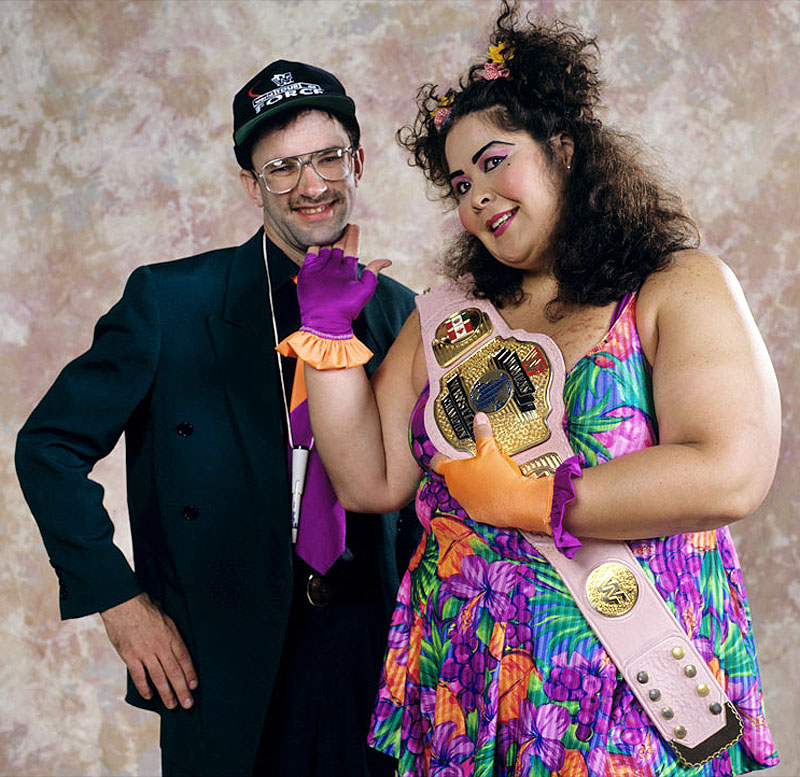With the first ever women's Money in the Bank match in the books and the WWE Women's Tournament (the Mae Young Classic), I thought it would be interesting to look at how women's wrestling has changed over time.
In Japan, joshi puro, what the Japanese call women's wrestling, has been very prominent since the 1970s. Peaking between the mid 1980s and the 1990s, when talent like Manami Toyota, Aja Kong, and Kyoko Inoue were performing joshi puro has much more in common with Japanese strong style than what was happening with women's wrestling in North America at the time. Dave Meltzer considered many joshi puro matches from this era as some of the best matches, regardless of gender, in the world at the time. If you watch the upcoming Mae Young Classic on the WWE Network, you will most likely be seeing Io Sharai, Kairi Hojo, and Asuka, all of whom are top former or current Japanese talent.
While the Japanese pro wrestling scene has tended to keep the men and women separate, Mexico embraces the idea of the women competing with the men. Female luchadoras have often mixed it up with the male luchadores, although many promotions still keep a women's division. Famously, AAA has both a reina de reinas (queen of queens) championship and tournament, and a mixed tag team championship, where teams must consist of one male and one female. It is worth noting that the (male) exotico character Pimpinela Escarlata once held the reina de reinas belt for 137 days before dropping it to Sexy Star and the mixed tag titles are currently vacant, as Sexy Star and Pentagon Jr relinquished the titles in February of 2016. The previously mentioned Sexy Star also holds the honor of being the only female Lucha Underground champion, as well as the only female Lucha Underground gift of the gods champion. This is especially noteworthy when you consider that both of these titles have each only had seven different competitors hold them.
In the United States, the two biggest promotions (TNA and the WWE) seem to have had very different histories with female performers. TNA has always treated the knockouts division as one of the highlights of the show. Having been home for incredible talents like Gail Kim and Awesome Kong, who had one of the greatest feuds in company history, it should come as no surprise they were treated so well. Every woman in the ring seemed to have their own unique character, which is something that hasn't always been the case for the WWE.
The WWE has always had an interesting relationship with how they treat women. On the one hand, they own the lineage of the NWA world women's championship, having bought the rights from the Fabulous Moolah. This means that they can claim supporting women's wrestling all the way back to 1956, although the company didn't come into existence until 1963. This version of the title has Moolah being a 5 time champion for a combined 11,091 days. Throughout her career, Moolah came under criticism for taking young female talent under her wing, only to then allegedly sell them as sex slaves to performers, using them often to advance her own career. She also was notorious for politicking her way to continuously be booked at the top of the female division to a degree even Hulk Hogan would be jealous of. While some might argue that Moolah paved the way for women wrestlers, I believe she did just as much, if not more, to delay the growth of anyone other than herself.
From 1984 through 1990 seemed to be treated more like a novelty than an actual competition. From Wrestlemania 1 through Rockin' Robin earning the title, every time the title changed hands was at a live event. When Rockin' Robin left the WWF, the title was deactivated. In 1993, the title was finally reactivated when Alundra Blayze won a six-woman tournament to become the latest women's champion. During this era of WWF's relationship with women's wrestling, while Alundra Blayze vs Bull Nakano felt like a good enough feud, they were really the only competitors worth mentioning. After the feud between these two ended the WWF brought in Bertha Faye. To generate more interest in the women's division, the creative team thought it was a good idea to bring in a comedic character. Faye's gimmick revolved around the idea that she lived in a trailer park and was in love with her manager, Harvey Whippleman. Surely that will sell tickets. While the company may have been looking to have a three woman division, just before Faye's debut, Nakano was arrested for possession of cocaine. After Faye captured the title and held it for just under two months, Blayne regained the title, before leaving the company. In what was considered a very controversial moment, analyze, now going by Medusa, threw the WWF women's title in the trash, literally. While this was also an appropriate metaphor for the state of women's wrestling, WCW was doing no better. Marisa seemed to float around for a few years,every now and then getting a storyline. During her time in WCW she developed a passion for monster trucks, which is what she does now.
When the Attitude Era began, women's wrestling started to pick up steam again. There were many legitimate talents at the start of the era, including Molly Holly, Jacqueline, and Ivory. There was also the "ninth wonder of the world" Chyna. For every one of these competitors with legitimate wrestling pedigrees, there was a Sable, a Debra McMichael, or a Terri Runnels. These three had little to no wrestling talent but were pushed to the top of the card because of their looks. Eventually the WWF brought in a fitness model named Trish Stratus. Trish was initially brought in as a valet for the tag team of Test and Albert, or T&A (get it?...) but eventually found herself involved with a storyline with the owner of the company, Vince McMahon. While Trish was certainly pushed into the main event scene because of her looks, she was improving in the ring. Stratus had a lengthy, career-defining feud with Lita, a feud that would cause both names to regularly enter the conversation of greatest female talent in the US of all time.
As the Sables, Terris, and Debras started to move away from in-ring action, they were being replaced by equally beautiful talent with significantly more skill. With that said, this certainly didn't all of a sudden make everything okay. The women would still find themselves competing in "bra and panties matches", "gravy bowl matches", and "lingerie pillow fights". You would still see certain women receive title Reigns purely because of their looks, despite being dangerous workers. And when the WWE split their roster, one half of the talent started competing for the divas title, which of course was silver and had a butterfly on it. When the rosters were unified once again, they took the divas title as the new legitimate women's belt. While this was clearly a branding move, the name still comes across as insulting. The "Total Divas" television program era had begun. The female performers were suddenly being booked to the needs of a reality show. Notably, when AJ Lee pointed this out, she was playing the role of the heel. There were weeks when the women, or "divas," were given less than five minutes of programming. In NXT, women like Paige, Emma, Becky Lynch, and Sasha Banks were tearing it up, but it didn't translate to time on the main roster.
When Paige started to develop a bit of a following, as well as the "Total Divas" stars Brie and Nikki Bella, fans started to take notice. The Bella Twins, Natalya, Paige, and others were making a connection with the crowd, but still weren't getting what the viewers found to be fair tv time. This sparked the #GiveDivasAChance movement. After enough attention was drawn to the lack of time and storyline the majority of the women get, the WWE had Stephanie McMahon come to the ring and declare that there has been a "women's revolution" in wrestling. The "voice of the WWE universe" had been heard. Immediately announcing that Sasha Banks, Becky Lynch, and Charlotte Flair were now all on the main roster, she broke the women's roster into three teams. For the next several months, the women would have a weird series of matches where you would see some combination of these teams facing off on every show, often in two segments. While the storyline was still weak ("hey look! This is a revolution" mixed with a lackluster sense of gang warfare), the women were starting to get decent airtime. Even better, the majority of these women could really go in the ring.
Soon, the WWE declared the Divas title was being replaced. In a one on one match, Charlotte defeated Nikki Bella to become the newest WWE women's champion. By October of 2016, it seemed as if the women's revolution was no longer just a marketing ploy. At the Hell in a Cell pay per view in Boston, Sasha Banks and Charlotte headlined the night in a Hell in a Cell match. Not only was this the first women's Hell in a Cell, the two were trusted with the main event spot.
Women's matches are getting more and more gimmicks added to them. Kendo stick on a pole, 30-minute iron man, Hell in a Cell, and last night was the first ever women's Money in the Bank match. In a moment that was meant to be the highlight of how far the women have come, we would see one of the five women involved climb to the top of the ladder and retrieve the briefcase. It should have been a moment that would go down in WWE history. Instead, James Ellsworth took the case down, before tossing it to his friend Carmella. For those not familiar with who James Ellsworth is, he is a comedic jobber, who rarely has any matches, and basically has a contract because he is a funny looking man. This was built to be one of the best moments of the year, but it was spoiled for an attempt at cheap heat. This just shows that the revolution still has a long way to go. Are we seeing steps in the right direction? Yes, but last night was two giant steps back. The WWE not only needs to get with the times when it comes to how they treat and portray women, they need to get with the rest of their own industry.












Its great to see how far women have come in wrestling and hopefully what it will bring in the future. I was surprised myself at how it went so far back 1956 wow!
ReplyDeleteYeah, I'm glad to see it becoming viewed as less of a novelty act and more as a legitimate part of the show.
DeleteEric - UML Class of 2010? English Creative Writing? Andre Dubus? I wrote an essay about you once for class. Great article and happy to see that you're writing. - Did this just get stalkerish? Email bonjoursofija@gmail.com if you remember me - Tyisha Jackson.
ReplyDelete